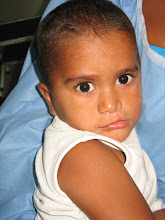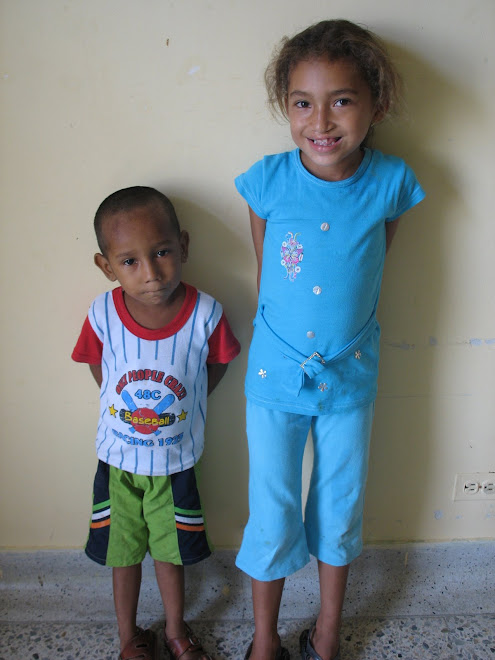 We step outside the hospital after a long day to find Luis and his Papa pacing in front of the locked doors. Papa, a 22-year-old rice salesman, has traveled nine hours with five-month-old Luis to be here.
We step outside the hospital after a long day to find Luis and his Papa pacing in front of the locked doors. Papa, a 22-year-old rice salesman, has traveled nine hours with five-month-old Luis to be here.
Although all the surgeries for the week have been scheduled, I hear Luis say, "Can't you fit adorable-little-me in somewhere?"
 Dr. Fenner must have heard this, too, because within two minutes we are back in the hospital collecting information. Luis is squeezed in on Friday.
Dr. Fenner must have heard this, too, because within two minutes we are back in the hospital collecting information. Luis is squeezed in on Friday.Luis & Papa head up to the sixth floor, where they will wait five days for Luis's surgery.

The next morning I go up to say hello and am surprised to meet Luis's Mama. Although she seems to care, it is Papa I always see playing with his son.

Luis has a cleft lip and palate. A cleft lip is an opening in the upper lip, which can range from a small notch up to the base of the nostril and can include one or both sides.
 hard palate is the bony portion of the roof of the mouth that opens into the floor of the nose. The soft palate is the soft portion back by the throat.
hard palate is the bony portion of the roof of the mouth that opens into the floor of the nose. The soft palate is the soft portion back by the throat.A cleft lip and/or palate occur when the tissues of the lip and/or palate of the fetus do not fuse early in pregnancy.
There are a number of side effects that can arise from clefts, including difficulty breathing and eating. Also, the palate prevents food and liquid from going up the nose when swallowing, so when there is a cleft, food often comes out the nose.
Children with a cleft palate may also experience numerous ear
 infections, because fluid and air can't pass normally through the eustachian tubes, which connect the throat with the middle ear. This means fluid may become trapped behind the eardrums, creating infection and hearing loss.
infections, because fluid and air can't pass normally through the eustachian tubes, which connect the throat with the middle ear. This means fluid may become trapped behind the eardrums, creating infection and hearing loss.Speaking clearly can also be a challenge for those with a cleft palate. Sometimes the soft palate doesn't prevent air from leaking out through the nose, which can make it sound as if they are speaking through their nose.
According to the Children's Hospital of the  University of Missouri Health System, there are a number of different factors that cause clefts, including genetics, ethnic background and certain environmental and chemical exposures. About one-third of infants born with clefts have a family history of clefting.
University of Missouri Health System, there are a number of different factors that cause clefts, including genetics, ethnic background and certain environmental and chemical exposures. About one-third of infants born with clefts have a family history of clefting.
- Native Americans: 3.74/1000 births
- Chinese: 1.45/1000 to 4.04/1000 births
- Caucasians: 1.43/1000 to 1.86/1000 births
- Latin Americans: 1.04/1000 births
- Africans: 0.18/1000 to 1.67/1000 births
The Big Day is Here!!

 I talk with Dr. Abraham while he performs surgery on Luis.
I talk with Dr. Abraham while he performs surgery on Luis.He says that today he operates on Luis's lip, but not his palate, because you don't want to operate too early on bone. The standard is to wait until the baby is 10 weeks to operate on a cleft lip, and 9 months for a palate.
Dr. Abraham tells me that operating on Luis's lip today will help with his feeding and speech. It will also help cosmetically, because the lips form more naturally as they heal. Clefts can become larger if you wait.
Next time he comes to Santa Marta, Dr. Abraham says, he will operate on Luis's palate. He plans for another mission April 2010.
Onto the recovery room:


Why are these nurses always honing in on my men?


After a few hours, Luis & Papa are back to the sixth floor, in the post-op area.



I say goodnight. It's been a long day....for everybody.


The next day is Saturday...our last morning at the hospital. The doctors make their rounds. Dr. Abraham admires his handiwork. Although still swollen, Luis will be Hollywood gorgeous in no time. And just wait until that palate is done.

Magnifico, Luis, bebe!





Thank you for sharing these amazing stories! It's beautiful!!
ReplyDeleteThanks for healing the children of this world.
ReplyDeleteMy wife was born with a cleft lip and palate. I can't thank you enough for educating people about this issue.
ReplyDelete